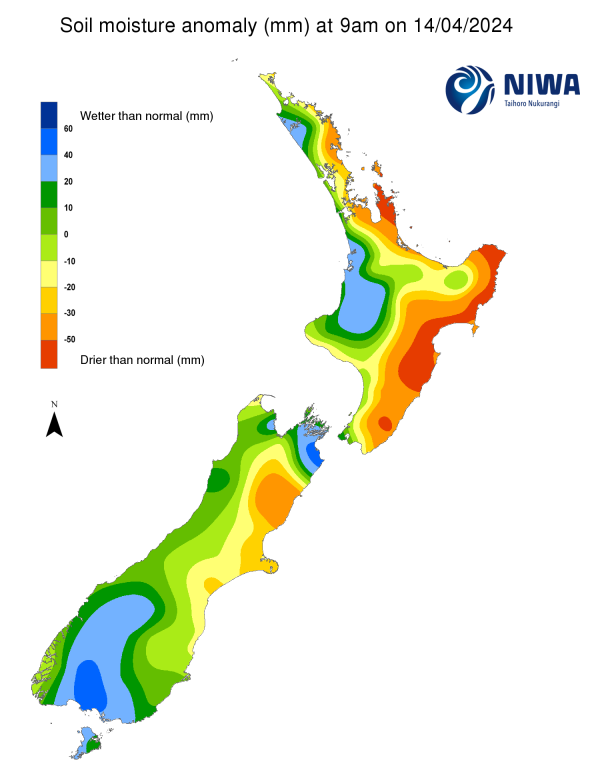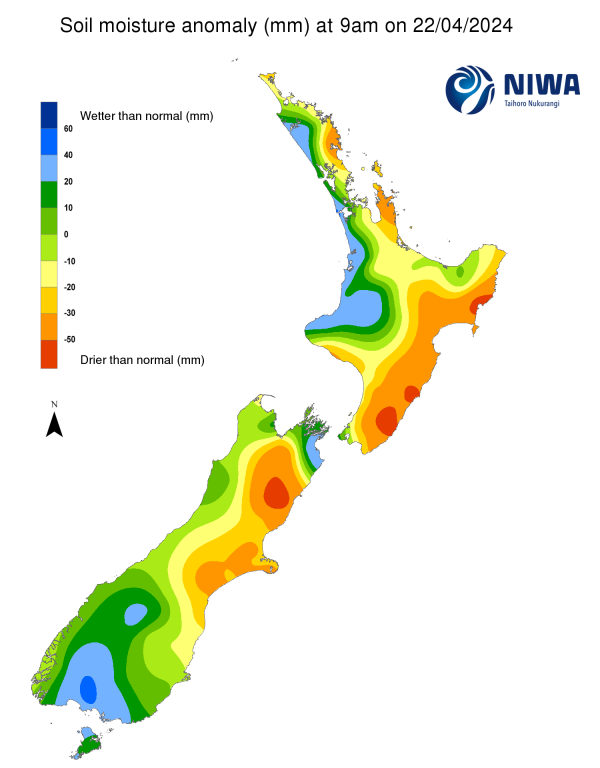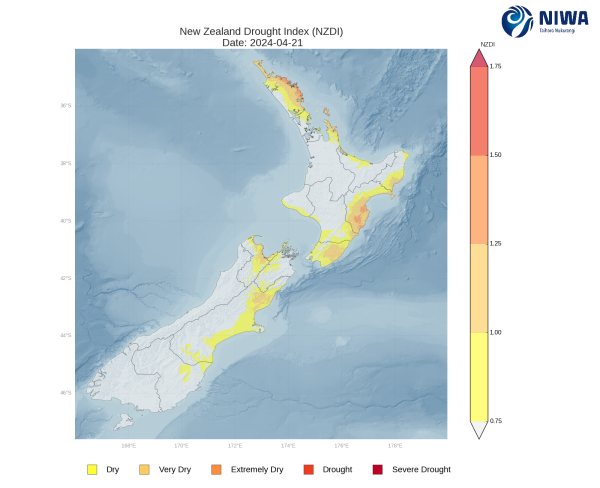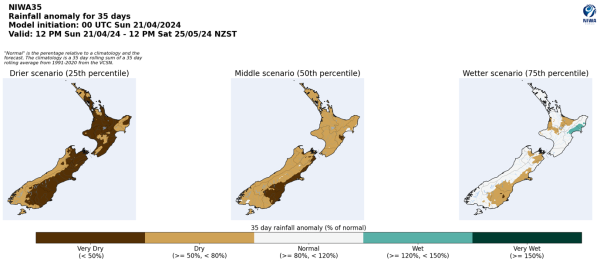A weekly update describing soil moisture patterns across the country to show where dry to extremely dry conditions are occurring or imminent. Regions experiencing significant soil moisture deficits are deemed “hotspots”. Persistent hotspot regions have the potential to develop into drought.
Recent rainfall and current soil moisture conditions:
North Island:
- The central North island generally saw rainfall totals of 25-50 mm in the past week, with localised amounts of 60 mm or more.
- Amounts of 15-30 mm were observed in the upper North Island along with Gisborne and Hawke’s Bay, while the lower North Island received meagre rainfall of 5 mm or less.
- Small to moderate soil moisture increases were observed in the Coromandel Peninsula, Bay of Plenty, Gisborne, and Hawke’s Bay, while small decreases occurred in Wairarapa. Elsewhere, little change was observed.
- The driest soils across the North Island, when compared to normal for this time of the year, are found in coastal Gisborne and Wairarapa, while the wettest soils for this time of the year are found in western Northland along with western and southern Waikato and northern Taranaki.
- Hotspots remain in place in a small portion of southern Gisborne, southern Hawke’s Bay, and Wairarapa, while previous hotspots in the Coromandel Peninsula have dissipated in the past week.
- As of 20 April, the New Zealand Drought Index (NZDI) map below shows that abnormally dry conditions are currently found in Northland, northern Auckland, Coromandel Peninsula, coastal Bay of Plenty, coastal Gisborne and Hawke’s Bay, coastal Taranaki, southern Manawatū-Whanganui, and Wellington. Very dry to extremely dry conditions are located in eastern Northland, northern Coromandel, coastal Gisborne, southern Hawke’s Bay and Wairarapa.
South Island:
- Rainfall amounts of 75-150 mm were observed in Fiordland and the far southern West Coast in the past week, but the rest of the West Coast and Southland only received 10-25 mm.
- Meanwhile, the upper and eastern South Island received meagre rainfall amounts of 5 mm or less.
- This resulted in small to moderate soil moisture decreases across a majority of the South Island.
- The driest soils across the South Island, when compared to normal for this time of the year, are found in northern Canterbury, while the wettest soils for this time of the year are found in Marlborough and western Southland.
- Hotspots remain in place across coastal portions of northern and central Canterbury.
- As of 20 April, the New Zealand Drought Index (NZDI) map below shows that abnormally dry conditions are currently found in northern Tasman, Nelson, western Marlborough, parts of Canterbury, and northern Otago. Very dry to extremely dry conditions are located in northern Tasman, Nelson, and parts of northern Canterbury.
Soil Moisture Anomaly Maps, relative to this time of year. The maps show soil moisture anomalies over the past two weeks.
As of 20 April, the New Zealand Drought Index (NZDI) map below shows that abnormally dry conditions are currently found in Northland, northern Auckland, Coromandel Peninsula, coastal Bay of Plenty, coastal Gisborne and Hawke’s Bay, coastal Taranaki, southern Manawatū-Whanganui, Wellington, northern Tasman, Nelson, western Marlborough, parts of Canterbury, and northern Otago. Very dry to extremely dry conditions are located in eastern Northland, northern Coromandel, coastal Gisborne, southern Hawke’s Bay, Wairarapa, northern Tasman, Nelson, and parts of northern Canterbury. Please note: some hotspots in the text above may not correspond with the NZDI map. This difference exists because the NZDI uses additional dryness indices, including one which integrates the rainfall deficit over the past 60 days. Changes are therefore slower to appear in the NZDI compared to soil moisture anomaly maps that are instantaneously updated.
The week ahead:
North Island:
- Dry weather is expected on Wednesday and most of Thursday (24-25 April), followed by a front that will bring light to moderate rain mostly to the western half of the North Island on Thursday night and Friday.
- From Saturday (27 April), several days of dry weather are possible as high pressure sits over the North Island.
- Weekly rainfall totals are likely to be meagre across much of the North Island with amounts of less than 15 mm, although totals up to 25 mm will be possible along the western coast.
- Due to the expected rainfall in the next week, at least small soil moisture decreases will be likely across much of the North Island.
- Current hotspots located along the east coast could strengthen slightly in the next week.
South Island:
- Showers will move through the West Coast on Wednesday (24 April), followed by rounds of moderate to heavy rain on both Thursday and Friday.
- After generally dry weather from Saturday to Monday (27-29 April), another front may bring showers or rain to the West Coast and lower South Island on Tuesday.
- Weekly rainfall totals could reach 75-150 mm along the West Coast, with up to 40 mm possible in the lower South Island.
- However, light rainfall totals of 15 mm or less are likely in the upper and eastern South Island.
- Due to the expected rainfall in the next week, some soil moisture decreases may occur in the upper and eastern South Island, with other regions potentially seeing small increases.
- The current hotspots located in Canterbury may strengthen at least slightly in the next week.
Long-term outlook (through late May):
- The drier (25th percentile) and middle (50th percentile) rainfall scenarios both show below normal to well below normal rainfall widespread across both islands.
- Even in the wetter (75th percentile) scenario, below normal rainfall is signalled across parts of both islands, increasing confidence in a below normal rainfall outcome, especially in the upper North Island and eastern South Island.
- Very dry soil conditions may affect parts of eastern NZ, particularly in the drier scenario.
Pictured above: 35-day forecast rainfall anomaly scenarios (Top), and 35-day forecast dryness and drought scenarios (Bottom). These maps are updated daily at https://niwa.co.nz/climate/seasonal-climate-outlook






